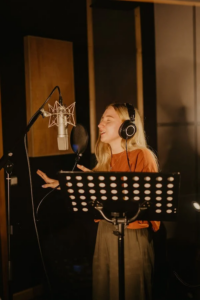To employ a forced perspective, one does not need to be an expert. However, you must have probably seen your pals use the strategy to publish images. It has been used in some of the most classic films. Even semi-professional photographers use it to create unique visual aspects for the internet. So, how can you put it to good use and come up with unique and creative photographs or footage? Let’s get started by defining forced perspective and its varied features.

What is Forced Perspective?
Forced perspective is a technique that utilizes optical illusions to make objects appear larger, smaller, farther away, or closer than they are. Human visual perception is influenced by observing the relationship between sized items and the camera or spectator’s position.
Filmmakers frequently utilize forced perspectives to show fictional realms in which humans are much larger or smaller than other characters. The camera can create unique visual effects in forced perspective photography, allowing humans to interact with objects or other subjects in previously inconceivable ways. One individual stepping on the Eiffel Tower is an illustration of this.
The Mechanics of Forced Perspective
How to Make Use of Forced Perspective
- Bring the subject closer to the camera for a more dramatic effect.
- For a smaller effect, move the topic farther from the camera.
- Make use of a wide-angle lens.
- Use a small aperture, like f/16
Factors to be Considered Before Using Forced Perspective
Space
If you have a lot of room to work with, setting up your subjects and items may be a little easier.

Position
The larger a subject or item seems, the closer it is to the camera, especially in comparison to a subject or object further away. Similarly, keep something far away from the camera if you want it to appear small.
Narrow Aperture
When we have two subjects with a reasonable distance between them, it’s critical to choose a camera setting that allows us to keep them both in focus. This is why we’d like a somewhat small aperture. An aperture of f/16 should suffice. Refresh your grasp of how aperture works, if necessary, because this fundamental understanding will be your best ally. It’s also recommended to aim for the center of your topic.

Wide Angle Lens
Wide-angle lenses provide more alternatives for a variety of subject sizes. It’s a lens with a focal length of less than 35 mm.

Best Examples of Forced Perspective
Camera Angle
Your camera angles indeed play a creative part in a compelling forced perspective in photography and videography. Either from a low angle or a high angle, the moments are captured. For low-angle forced perspective shots, you must place the camera on the ground or lie on the ground. While you shoot a large subject from a low angle, the image gives a feeling of depth, intensity, and magnanimity.

In the case of high-angle shots, you tilt your camera downwards to focus the subject. This shot is also known as a bird’s eye view. Converse to low-angle shots, high-angle shots in forced perspective techniques cover the subject in its totality. Moreover, such images are descriptive, covering the background as well. Hence filmmakers and photographers put their creativity into their shots while choosing their settings.
Planning
You will need to think about your composition to accomplish forced perspective photography genuinely. When elements are slightly off, the optical illusion becomes less convincing.
It also helps if you are familiar with your surroundings and have practiced how close or far you should be from the various elements in your photograph.
You do not have to have every aspect figured out, but you should have a solid idea of what you’re doing. The more you plan ahead of time, the more quickly you can complete your shot.

Keep it Simple
Regardless of genre or style, simplicity in the composition is crucial. It is critical with a forced viewpoint.

Optical illusions need near-perfect composition, and each additional feature added to the frame increases the chances of something going wrong.
Ensure that everything in the frame contributes to the optical illusion. Any additional items that make it into the photo run the danger of obscuring the original perspective’s context.
As a result, the impact of the fresh perspective you’re attempting to accomplish will be diminished.
Work with a Partner
Alone-forced perspective photography can be challenging. Fine-tuning the location of objects inside a composition frequently necessitates a lot of going back and forth from them to the camera’s viewfinder, which can be time-consuming.

Location
Picking the correct place and choosing good props may significantly impact your final images. A forced perspective image might technically be shot in almost any area. However, some locations are more accessible to shoot than others.
The most typical issue is other individuals crowding your shot and pressuring you to finish quickly. Crowds can throw off the composition of your photo and disrupt the optical illusion, in addition to putting you under time pressure. Therefore, the most convenient venues are free of crowds and have enough space to move around in.
If you want to photograph in a busy area, such as a popular tourist attraction, go early in the morning when the crowds are smaller.

Props
You should use props if you can’t find a companion for the shoot. A self-portrait is also conceivable, but it’s a pain unless you know how to shoot tethered. You can have problems getting the correct composition if you don’t, which takes a lot of trial and error to get it right.
Furthermore, if you choose the correct props, props can be just as intriguing as portraits. The finest props have some relationship to the environment, reinforcing the foreground-background connection.
For example, Michael Hughes, a British photographer, has a popular photo series that blends forced perspective and trip mementos.

Be Creative
It’s a lot easier to have someone move the objects around according to your instructions. Also, things need to be held at times, and your composition may require a human subject. Having an extra person on hand can assist you with your photoshoot.
If you do not have any pals eager to assist, consider contacting other photographers and taking turns to compose and shoot. Besides speeding up the shots, you might also come up with fresh ideas due to the collaboration.

Forced Perspective in Filmmaking
A scenario in an action film in which dinosaurs menace the heroes is an example of forced perspective. By positioning a miniature model of a dinosaur close to the camera, the filmmaker may make the dinosaur appear monstrously tall. However, it is only a few feet away.
Clever Forced Perspective Ideas
Citizen Kane resurrected the practice of forced perspective, which had been a characteristic of German silent cinema. In the 1950s and 1960s, particularly B-movies, films were made on a shoestring budget and frequently included forced perspective shots.
When the environment obscures the disparity in perspective, forced perspective becomes more realistic. For example, the renowned film Casablanca’s last sequence takes place at an airport in the middle of a storm. However, the entire scenario was shot in a studio. This was accomplished by employing a painted aircraft backdrop “serviced” by dwarfs standing next to it. As a result, the viewer’s attention is drawn away from the scene and extras by a downpour, making the simulated perspective less visible.
Forced perspective is used extensively in Peter Jackson’s Lord of the Rings cinematic adaptations. Characters who appear to be standing next to each other would be separated from the camera by many feet. This makes certain characters appear significantly smaller than others in a still photo. If you adjust the camera’s point of view, the parallax will show the characters’ accurate relative positions in space. Even if the camera is rotated, if it is not rotated at the correct point, the camera’s point of view may move unexpectedly. This point of view is known as the ‘zero-parallax-point .’ It is roughly equivalent to the entering pupil’s center in practice.
An enhancement of the Zero Parallax point employed in moving shots was widely used in The Lord of the Rings: The Fellowship of the Ring. Parts of the sets were installed on moveable platforms that moved precisely with the camera’s movement, ensuring that the optical illusion was maintained throughout the shot.

The same techniques were employed to make Hagrid look like a giant in the Harry Potter films. Objects around Harry and his friends are regular size, whilst props near Hagrid appear to be identical but are actually smaller.
The same techniques were employed to make Hagrid look like a giant in the Harry Potter films. Objects around Harry and his friends are regular size, while props near Hagrid appear identical but smaller.
A holiday classic is an example of a film. Nothing quite captures the holiday spirit like the giant-sized elf from the movie Elf.
Director Michel Gondry’s Eternal Sunshine of the Spotless Mind had a similar intention in mind. With just the picture-perfect camera trickery, he might drastically reduce the quantity of CGI.
The production team gave the audience a visual treat of a forced perspective kitchen frame, to give us a child-sized Jim Carrey in the scene where Joel brings Clem to a childhood recollection.
Eternal Sunshine of the Spotless Mind Forced Perspective
Forced Perspective at Theme Parks
The use of forced perspective is common in theme parks. Other similar architecture, such as that found in Disneyland and Las Vegas, makes structures appear larger than in reality. Physically larger structures would not be feasible or desirable, so filmmakers provide an optical illusion for entertainment value. Walt Disney Imagineering, for example, uses it in the Disney Theme Parks. Castles are famous examples of forced perspective in parks, which is employed to make items appear larger. The American Adventure pavilion in Epcot is one of the most outstanding examples of forced perspective being used to create an object that appears smaller.

Sleeping Beauty Castle.

Cinderella Castle.

The American Adventure Pavilion.
Image Source: Disney
Forced Perspective Instructional Videos
Conclusion
Forced perspective as an in-camera photographic technique has numerous advantages, notably in terms of creativity.
It demands you to consider what you see in significantly different ways from what conventional human perception suggests.
Many forced perspective photos can, of course, be readily generated in Photoshop. Still, the out-of-the-box thinking required for unique in-camera photos can benefit all of your other photographic genres.













